
May 2023
For Workers Action Against U.S. / NATO / AUKUS Imperialist Axis
Australia
Spearheads Anti-China
War Drive in the Pacific Islands
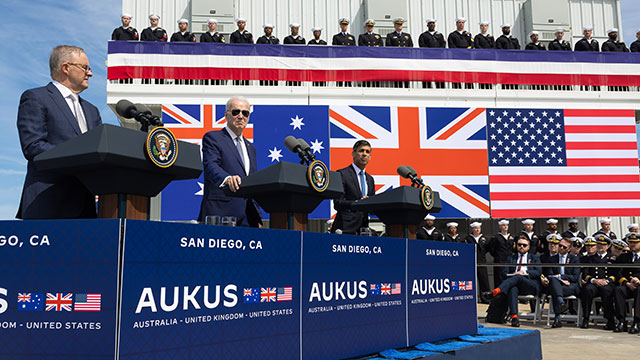
Australian prime minister Anthony Albanese (left) together with U.S. president Joe Bidden and British (U.K.) prime minister Rishi Sunak at naval station in San Diego, California on March 14 announce plan to build nuclear-powered submarines for Australia. Target: China. (Photo: Simon Walker / No. 10 Downing Street)
SYDNEY, Australia – Ever since World War II, Australia has acted as deputy sheriff for the United States in the Pacific. This was formalised in the 1951 Australia-New Zealand-U.S. (ANZUS) security treaty, and from the beginning was directed at the “Communist threat” from the 1949 Chinese Revolution. But the loose coordination of ANZUS was replaced in 2021 with the formation of the trilateral Australia-U.K.-U.S. (AUKUS) military treaty explicitly targeting Beijing.1 Recently there has been a flood of warmongering rants from Western political/military leaders and media mouthpieces foreseeing war with China in the very near term, with the Australian military slated to act as a spearhead in the strategic Pacific Islands region. And following the threats has come action.
In a special three-part series in March titled “Red Alert,” the Sydney Morning Herald and Melbourne Age assembled a team of “expert” China hawks threateningly warning that “Australia faces the threat of war with China within three years – and we’re not ready” (“Australia’s holiday from history is over”, The Sydney Morning Herald, 7 March). Six days later, Australian prime minister Anthony Albanese stood on the pier at the U.S. naval base in San Diego together with U.S. president Joe Biden and British prime minister Rishi Sunak where they announced a deal under which Australia would buy nuclear-powered submarines of British design and U.S. technology. This was accompanied by an agreement that U.S. attack subs (typically armed with nuclear missiles) would rotate through Perth, Western Australia.
There is only one possible purpose for Australia acquiring nuclear subs: war on China.
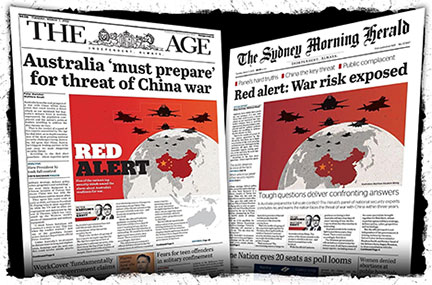 In an orchestrated
campaign, leading Australian newspapers beat drums for war
against China with anti-communist “Red Alert” series. Two
days after the first installment was published, Australian
prime minister meets with U.S. and U.K. leaders (above) to
announce AUKUS alliance plans to expand nuclear war fleet.
In an orchestrated
campaign, leading Australian newspapers beat drums for war
against China with anti-communist “Red Alert” series. Two
days after the first installment was published, Australian
prime minister meets with U.S. and U.K. leaders (above) to
announce AUKUS alliance plans to expand nuclear war fleet. The “Red Alert” authors champion breaking “taboos” by reviving military conscription and acquiring nuclear weapons to meet the China “threat”. They insist that Australia needs to double its defence spending to preserve peace. One of the these “experts,” former Australian Defence Department deputy secretary Peter Jennings, said: “I want us to think about what can we do which gives us a capacity, at the furthest projection from our shores, to be able to sink the Chinese Navy and to bring down their aircraft?” (Sydney Morning Herald, 9 March). Meanwhile, this warmongering verbiage is accompanied by ominous statements by U.S. military leaders. NBC News (28 January) reported:
“Four-star Air Force General Mike Minihan, head of Air Mobility Command, sent a memo on Friday to the officers he commands that predicts the U.S. will be at war with China in two years and tells them to get ready to prep by firing ‘a clip’ at a target, and ‘aim for the head.’ In the memo sent Friday and obtained by NBC News, Minihan said “‘My gut tells me will fight in 2025’.”
Another segment of the “Red Alert” series stated:
“Former chief of the US Indo-Pacific Command, Philip Davidson, has said China may try to attack Taiwan by 2027. Last October, Admiral Michael Gilday, chief of US naval operations, said an attack could come as early as this year.”
–“‘Australia’s holiday from history is over’,” Sydney Morning Herald, 7 March
These are not merely the hysterical ravings of a lunatic fringe. They reflect official U.S. policy. Amid the escalating imperialist war on Russia over Ukraine, the latest U.S. National Defense Strategy (October 2022) declares the People’s Republic of China (PRC) the main enemy: “The PRC presents the most consequential and systemic challenge, while Russia poses acute threats – both to vital U.S. national interests abroad and to the homeland.” China tops the list of military priorities: “Defending the homeland, paced to the growing multi-domain threat posed by the PRC,” and again, “being prepared to prevail in conflict when necessary – prioritizing the PRC challenge in the Indo-Pacific region, then the Russia challenge in Europe.”
Recently the Albanese cabinet in Canberra (Australia’s capital) has followed suit with its own Defence Strategic Review (April 2023) declaring that “Intense China-United States competition is the defining feature of our region and our time,” and more specifically that “China’s assertion of sovereignty over the South China Sea threatens the global rules-based order in the Indo-Pacific in a way that adversely impacts Australia’s national interests.” This “new strategic reality,” it declares, requires “enhancing United States Alliance force posture arrangements in Australia” and adopting a “whole-of-government and whole-of-nation approach to security” – meaning that preparation for war is to be the top government and national priority, eclipsing all others.
Meanwhile, the New York Times (26 March) writes, the U.S. has now declared “the Indo-Pacific – ‘the priority theater’ for global security, according to the Defense Department, which has stationed 300,000 troops in the region.” Thus, “The Philippines, Japan, Australia, Palau, Papua New Guinea and U.S. territories across the Pacific are all working with Defense Department officials on expanding military access and facilities.” In Guam, where 22,000 U.S. troops are already stationed, another 5,000 Marines will soon be added in a new base on the island, and “a pier for nuclear-powered submarines is being upgraded. More than a dozen sites have also been identified as potential locations for missile defense systems, while Andersen Air Force Base has plans for a new weapons complex” (New York Times, 14 April).
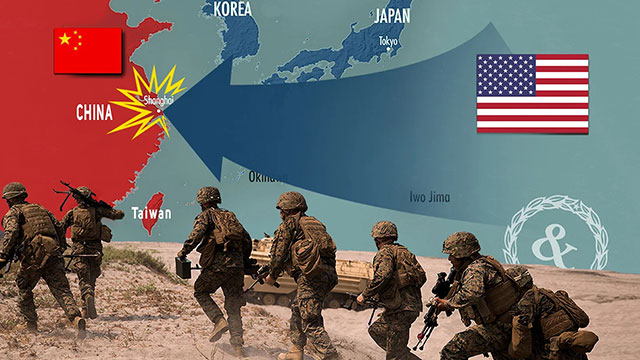
U.S. military aficionados getting ready for “the big one,” imperialist war against China. Illustration for article "Inside the US military’s modern ‘island hopping’ campaign to take on China," Task & Purpose, 16 June 2022.
Beijing is not blind to such threats. Chinese president Xi Jinping said in a March 7 speech that “Western countries – led by the U.S. – have implemented all-round containment, encirclement and suppression against us, bringing unprecedentedly severe challenges to our country’s development.” Chinese Foreign Minister Qin Gang likewise warned that Washington is pursuing a “hysterical neo-McCarthyism,” and that its “so-called ‘competition’ means to contain and suppress China in all respects and get the two countries locked in a zero-sum game.” And in March, Xi met in Moscow with Russian president Vladimir Putin, strongly reaffirming solidarity against the U.S. menace.
As revolutionary Marxists – Trotskyists – the League for the Fourth International defends the gains of the 1949 Chinese Revolution. China’s collectivised economy – although saddled with a conservative Stalinist bureaucracy and endangered by huge capitalist inroads – enabled it to successfully contain the COVID pandemic for three crucial years, preventing what would likely have been millions of deaths, and has lifted hundreds of millions of Chinese out of extreme poverty and imperialist subjugation. As Democratic administrations in Washington escalate its “pivot to Asia” and confrontation with China, while waging an escalating “proxy war” against Russia, the League for the Fourth International declared last October:
“[I]n the present situation, proletarian revolutionaries’ call to defeat the imperialists’ war drive against Russia and China (a bureaucratically deformed workers state) means standing for the defeat of the U.S./NATO proxy regime in Ukraine, and for military defense of Russia (a regional capitalist power) while giving no political support to, and calling for workers struggle against, the reactionary bourgeois nationalist Putin government.”
–“Defend, Russia, China Against War-Crazed U.S. Rulers,” The Internationalist No. 67-68, July-October 2022
While the bulk of the Australian left, driven by visceral anti-communist hatred of China, is mired in the Anti-AUKUS Coalition with its social-imperialist “butter not guns” program, the LFI fights to smash imperialism through international socialist revolution.
The AUKUS Imperialist Alliance
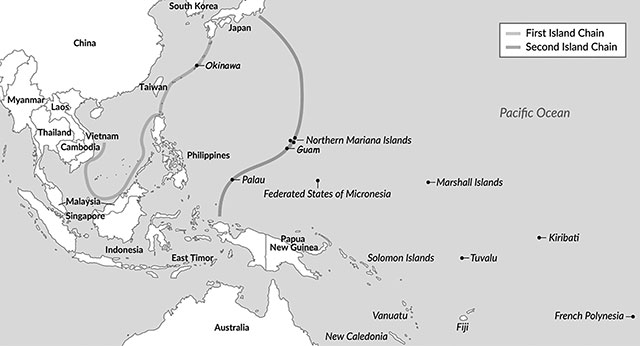
U.S. plans for imperialist war against China focus on fighting in the Pacific Islands, particularly the “second island chain” and further south. (Map adapted from GIS)
The AUKUS alliance was accurately described upon its launch by a BBC (16 September 2021) headline: “UK, US and Australia launch pact to counter China.” When in early March of this year, the leaders of the three imperialist powers – with Australia definitely the junior partner – gathered at the U.S. naval station in San Diego harbour, amidst blaring military bands and plenty of red, white and blue bunting, they showed where this anti-China axis is headed. It’s not just about economic “competition”: the Australia-Britain-U.S. military alliance is gearing up for nuclear war against the largest remaining deformed workers state in the world, which already has a larger naval fleet (623+ ships) than the combined active duty and reserve fleets of Australia, Britain and the U.S. combined (593 ships).
Under the deal announced in March, Canberra will acquire eight nuclear-powered subs. Initially, three second-hand U.S. Virginia-class nuclear submarines will serve as a stopgap from approximately 2033 (still ten years out). Britain will construct and operate the first AUKUS submarine from the late 2030s and acquire up to 12 more. Four American nuclear-powered submarines and one British vessel will begin rotating through Western Australian naval bases from 2027 onward to boost Australia’s ability to operate its own vessels in the 2030s and 2040s. Since Australian law formally prohibits foreign bases on Australian territory, these forces will be on “permanent rotation” and include nuclear-ready American B-52 bombers stationed in northern Australia, and new B-21 stealth bombers when they come on line.
Placing U.S. bombers in Australia’s north is supposed to ensure that the Pentagon’s strike capabilities will be beyond the range of most Chinese missiles (for now). In a statement to the ABC (Australian Broadcasting Corporation) on the B-52s, Richard Tanter, a senior research associate at the Nautilus Institute, warned: “It’s a great expansion of Australian commitment to the United States’ war plan with China. It’s a sign to the Chinese that we are willing to be the tip of the spear. It’s very hard to think of a more open commitment that we could make. A more open signal to the Chinese that we are going along with American planning for a war with China.”
The nuclear submarines deal will cost Australia up to US$368 billion, more than twice the original projected price and not counting the inevitable bloated cost-overruns that are the norm for private military contractors. (The AUKUS agreement replaced a contract under the previous Turnbull government for eight submarines to be supplied by France for $90 billion.) This is by far the single largest government expenditure of any kind in Australian history. Even the bellicose editors of the Sydney Morning Herald (14 March) wrote: “The numbers are so big they make your eyes wince and your breath catch in your throat…. It turns out all the impressive-sounding figures the experts have been using to estimate the cost of acquiring a fleet of nuclear-powered submarines…were low-balling it.”
Australia is also acquiring over 200 new-generation Tomahawk cruise missiles to the tune of US$895 million and additional space-based satellite infrastructure (price unknown) to support the AUKUS subs’ navigation, targeting and other intelligence purposes. This is in addition to beefing up the longstanding U.S./Australian spy and communication satellites maintained in the ultra-secret base at Pine Gap, part of the “Five Eyes” intelligence alliance between the US, England, Canada, Australia and New Zealand, which is an extension of a UK-U.S. agreement dating back to WWII.
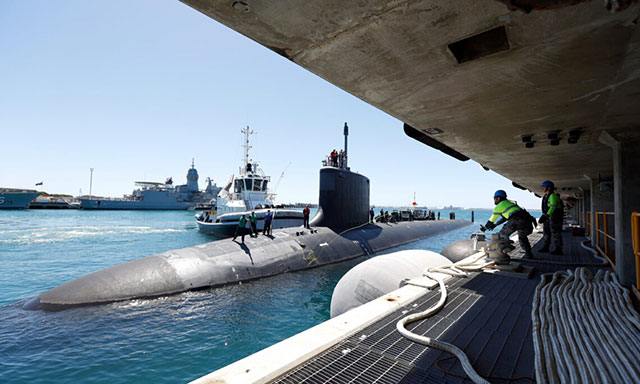
Virginia class submarine USS Mississippi at berth in Perth, Australia. U.S. escalating anti-China war plans call for rotating nuclear-armed subs through Australia’s western port. (Photo: U.S. Indo-Pacific Command)
Although the AUKUS deal has received broad bipartisan support from the main political parties, former Labor (ALP)2 prime minister Paul Keating kicked some chairs over in a sharp-tongued address to the National Press Club on March 15. Keating labeled the AUKUS submarine acquisition “Labor’s worst decision in government” since World War I. Despite Keating coming from Labor’s right wing, while Prime Minister Anthony Albanese and Foreign Minister Penny Wong’s roots are in the party’s “left,” Keating maintained that the current government makes him and other former ALP leaders “look like Bolsheviks.” Keating stated that China, which is Australia’s largest trading partner and heavily dependent on Australia’s iron ore for its steel production and construction industry, has no reason to threaten Australia and that AUKUS is solely in the service of a dubious alliance with the U.S.
Keating ridicules the idea that eight Australian submarines would have any bearing on “defending” Australia. He points out that the projected AUKUS subs are far too large to remain undetected in Australia’s shallow coastal waters, but instead are well-suited to be part of a U.S. first-strike military assault on the Chinese mainland, where they would lie in deep water just off China’s coastal seas and attack Chinese surface ships and subs. As for China, Keating lambasted Albanese’s government for “copying the nonsense coming from the Americans that the Chinese should live forever under their [U.S.] strategic command.” He predicted a “big reaction” from the Labor Party ranks against the deal.
Keating’s nationalist response to the American “big brother” reflects widespread unease in the population. A recent Guardian Essential poll (21 March) suggests Australians are at odds with the AUKUS deal, with just one in five voters labelling China a “threat to be confronted” and only one quarter in favour of paying the price tag of $368 billion. And this apprehension goes far beyond the AUKUS submarines. According to a recent Lowy Institute poll, 77% of Australians agree with the statement: “Australia’s alliance with the United States makes it more likely Australia will be drawn into a war in Asia that would not be in Australia’s interests” – up eight points since 2019. Moreover, 51% said “Australia should stay neutral” in any war between US and China.”
The pacifist/nationalist Anti-AUKUS Coalition (which includes a number of Australian unions such as the Construction, Forestry, Maritime, Mining and Energy Union, National Tertiary Education Union, Unions New South Wales, Unions ACT, New South Wales and Queensland Teachers, Maritime Union of Australia and others) does not oppose Australian imperialism per se but calls for a more “independent” foreign policy. Australian alignment with the U.S. is not merely a matter of “mistaken policy” as the coalition and former prime minister (PM) Keating assert. Instead, as a middling imperialist power, Australia has consistently aligned itself with the dominant imperialist power of the day, first Britain and then, early in World War II as the British empire collapsed in Asia, with the United States. The quid pro quo is that the U.S. will support Australian imperialism’s predatory activities in the Pacific, in exchange for Australian participation in U.S.-led wars and military interventions around the world.
The Pacific Islands: From “Benign Neglect” to Big Stick Threats
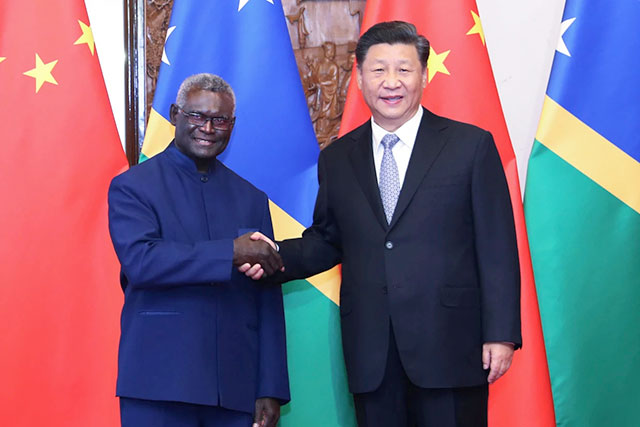
Solomon Islands Prime Minister Manasseh Sogavare and Chinese President Xi Jinping in Beijing in 2019. (Photo: Yao Dawei / Xinhua)
In the run-up to the Australian federal elections in May 2022, which saw the ALP defeat the decade-long rule of the conservative Liberal/National Party coalition government, “national security” became a red-hot issue. In early April, the leader of the Solomon Islands, Prime Minister Manasseh Sogavare, announced that his government had concluded a long-term security treaty with China, including military and police training. Australian politicians went nuts.
Most Australians and Americans could not locate the Solomons on a map if their lives depended on it. If they have some knowledge of the course of WWII in the Pacific, they will have heard of the Battle of Guadalcanal, the largest island in the Solomons, which was the first U.S. counterattack in the island-hopping campaign against Japan. The Solomons’ security deal with China was a rude awakening for Canberra and Washington. But it’s not like they didn’t have any warning: Sogavare formally severed ties with Taiwan in 2019 and established relations with Beijing. Of the 14 countries that still recognise Taiwan, four are small Pacific Island nations (the Marshall Islands, Nauru, Palau and Tuvalu), reflecting declining U.S. aid, growing ineffectiveness of Taiwan bribe money and increased influence from China.
The Solomons are among the poorest of the Pacific Island nations, with per capita income about half that in Fiji, about one-fifth of that in American Samoa and 1/15th of that in Guam. Ethnic tensions (e.g., against the Chinese in the Solomons, Indians in Fiji) have long been fueled by imperialist pressure in the region. Australia and New Zealand sent “peacekeeping” forces to the Solomons in 2003, which continued to occupy the country until 2017. Following the establishment of relations with the People’s Republic of China, there were anti-Chinese riots in 2021 sparked by leaders of the rebel Malaita province who were financed by massive aid (US$25 million) from Washington.3 In response, Sogavare appealed to Beijing for assistance in policing, and the April 2022 security treaty with China contained a clause permitting deployment of PRC forces to the Solomon Islands “to assist in maintaining social order.”
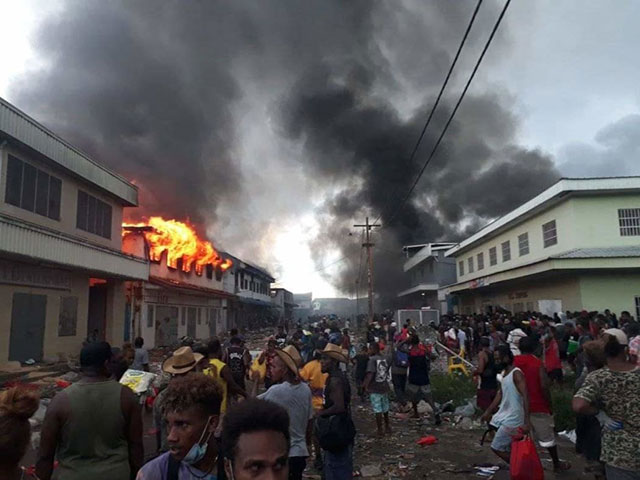
Riots target Chinatown section of Solomon Islands capital Honiara, 25 November 2021, instigated by provincial authorities of Malaita island, funded by the U.S. ($25 million) and Taiwan, to protest government’s recognition of People’s Republic of China. (Photo: Facebook)
When the news broke of the Solomons/China deal, Australian Prime Minister Scott Morrison belligerently stated that he would not allow a Chinese military base in the Solomons “on Australia’s doorstep,” declaring it a “red line” that would trigger a military response. (The Solomons are in fact 2,000 kilometers [1,500 miles] from Australia.) This was despite the repeated assurances by Solomons’ leaders that no Chinese military base was included in the agreement. The Labor Party pledged, if elected, to counter China’s growing influence by establishing an Australia-Pacific Defense School to provide training for the military and police forces of Pacific nations and to step up Australian aid to the region. And as soon as it took office, the new ALP government launched a whirlwind campaign of visits to the Pacific islands to escalate the anti-China pressure.
A U.S. delegation rushed to the Solomons in late April 2022 and issued barely veiled military threats. Assistant Secretary of State for East Asian and Pacific Affairs Daniel Kritenbrink told the media: “We’ve outlined the specific concerns that we have regarding the potential for a permanent military presence or power-projection capabilities or a military installation, and we’ve indicated that should those events come to pass, that the United States would respond accordingly. And I think it’s best if I leave it at that and not speculate on what that may or may not mean” (Sydney Morning Herald, 26 April 2022). Solomon’s leader Sogavare protested: “We find it very insulting to be branded as unfit to manage our sovereign affairs, or [to] have other motives in pursuing our national interests.” Sogavare later refused to sign an agreement drafted by the U.S. for a September 2022 Pacific Island Forum meeting.
Amid all the hullabaloo about putative Beijing plans for military bases in the Pacific Islands, it is worth noting that as the world’s largest and most belligerent imperialist power, bent on “projecting power” just about everywhere on the globe, the U.S. maintains some 750 military bases around the world. China, however, has exactly one (1) foreign base: a naval facility in Djibouti. This is a choke point between the Red Sea and Gulf of Aden where Germany, Japan, Spain, Italy and the U.S. also have military bases, the U.S.’ being the largest.
Days after the May 2022 elections, Australia’s new PM Albanese and foreign minister Penny Wong had the governor-general (representative of the British monarch) quickly swear them into their positions so they could fly to Tokyo for a meeting of the Quad alliance (U.S., Japan, India and Australia). Having received marching orders from the U.S., Wong visited Fiji, Samoa, Tonga and then the Solomons. Later, in December, Wong and defence minister Richard Marles held meetings in Washington with U.S. secretary of state Antony Blinken and defence secretary Lloyd Austin, to “advance cooperation in the Indo-Pacific region and globally.” Just before Christmas, Wong led an Australian parliamentary team to visit Vanuatu, Palau and the Federated States of Micronesia, and signed a security pact with Vanuatu which promised an increased Australian Defence Force presence on the island.
Washington, and hence Canberra, have worked themselves into a lather over spreading Chinese influence in the regions of Micronesia, Melanesia and Polynesia, as Beijing has signed economic cooperation agreements under the Belt and Road Initiative with ten Pacific Island nations. The imperialist press reflects the panic, as in the New York Times (23 January) article on the Solomon Islands headlined, “China’s Mad Dash into a Strategic Island Nation Breeds Resentment.” As the U.S. mandates Australia to tighten control of the region with neocolonial mechanisms, Trotskyists call for the revolutionary overthrow of capitalist-imperialist domination, as well as for the independence of New Caledonia (a French colony) and French Polynesia (including Tahiti), and the creation of a voluntary Socialist Federation of the Pacific Islands.
Australia’s Role in the “Pivot to Asia”
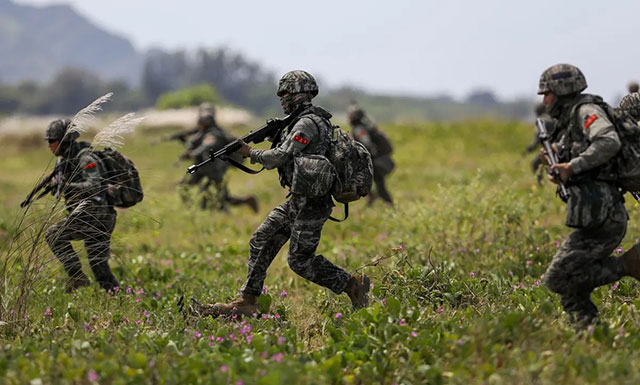
Imperialists are gearing up for war with China in near term. Above: South Korean marines practice beach landing during joint U.S.-Philippine military exercise north of Manila, April 2023. (Basilio Sepe / ZUMA Press)
The recent book by former Australian army intelligence officer turned academic Clinton Fernandes, now a professor at the University of New South Wales, Sub-Imperial Power: Australia in the International Arena (2022) refers to Australia as part of an “unbroken chain of U.S.-armed sentinel states,” which includes Japan, South Korea, Taiwan, the Philippines, Thailand, Singapore and India. While certainly no Marxist, Fernandes argues in an interview in the Melbourne newspaper The Age (31 December 2022) that as what he calls a “sub-imperial power,” Australia is dedicated to upholding the dominance of the United States: “the biggest lie at the moment is that we are doing ‘freedom of navigation operations’ in the South China Sea. We are not doing freedom of navigation operations, we are dropping sonar buoys in order to identify the acoustic signature of Chinese submarines, in order to attack them with the United States.”
But the Australian bourgeoisie have contradictory interests. Former prime minister Keating is a loyal servant of that power, but his tongue-lashing of Albanese reflects some undeniable realities. China became Australia’s largest trading partner in the years of neoliberal “globalisation” and its “opening up” to the West. As late as 2021, China accounted for eight times more of Australia’s trade than the U.S., and 80% of Australia’s total export value comes from China’s purchase of iron ore. China also became the “workshop of the world” attracting production facilities from imperialist economies with higher wage levels, mainly the U.S. and Europe. The rapid decline of Australian industries like auto and general manufacturing, textiles and footwear began under the ALP governments of Bob Hawke and Keating from 1983 to 1996 that removed Australia’s traditional protectionism. But this hasn’t stopped everything from job losses to high real estate prices being blamed on China.
Australia’s (economic) “pivot to China” was immensely profitable. Moreover, Australia was almost the only wealthy imperialist country to avoid a recession or depression in the decade following the global financial crisis of 2007-09. This was mainly due to the Chinese collectivised economy steaming ahead, feeding increased demand for Australia’s mineral exports. Meanwhile, profit margins in the U.S. and Europe nosedived and then flatlined for a decade. Having carried through a counterrevolution and opened up markets in the former Soviet Union and East Europe at the beginning of the 1990s, U.S. imperialism turned its sights on China. At first it sought to escalate pressures for the restoration of capitalism by increasing imperialist investment and integrating China into the World Trade Organization, International Monetary Fund, etc. But as Western economies tanked, the U.S. turned to increased confrontation with China, which is the meaning of Barack Obama’s 2012 “pivot to Asia.”
China became a target of increased competition and trade barriers by Western powers at the same time as military pressure intensified. Despite Washington’s professed adherence to a “One China” policy, U.S. support to Taiwan and attempts to seal off the South China Sea escalated. Nancy Pelosi’s August 2022 trip to Taiwan was a direct challenge to Beijing.4 Taiwan increased its 2023 military budget by 19%, backed by a $10 billion U.S. increase in military financing over five years plus $1 billion annually in equipment from Pentagon stockpiles. Cold War hawks, both Republicans and Democrats, want to stop China from recovering its lost province in order to block it from obtaining unrestricted access to the Pacific. “Saner” minds in the Pentagon realize that this is well-nigh impossible and seek instead to make a Chinese takeover as costly as possible. Also unsure about the Philippines, they look to Australia to shore up the “second island chain” (see map on page 25).
Australia’s bourgeoisie is caught in a bind. On the one hand, its economy has become heavily dependent on trade with China (particularly commodity exports like minerals), yet strategically it is dependent on its imperialist godfather, the United States. And not just militarily. According to Bloomberg, foreign investors own as much as three-quarters of shares in the top 20 companies on the Australian Stock Exchange (ASX), making up roughly half the market capitalisation of the entire ASX, while U.S.-based investors are the biggest owners of 16 of those 20 companies. If Washington and Wall Street give the orders, Canberra will have little choice but to salute, as Australia’s European fellow imperialists have done with anti-Russia sanctions. But should Beijing justifiably retaliate economically for anti-China moves by Australia, as it did in 2021, imposing tariffs on a range of Australian exports, Australian workers would pay the price.
Australia Lays Waste to the Pacific Islands
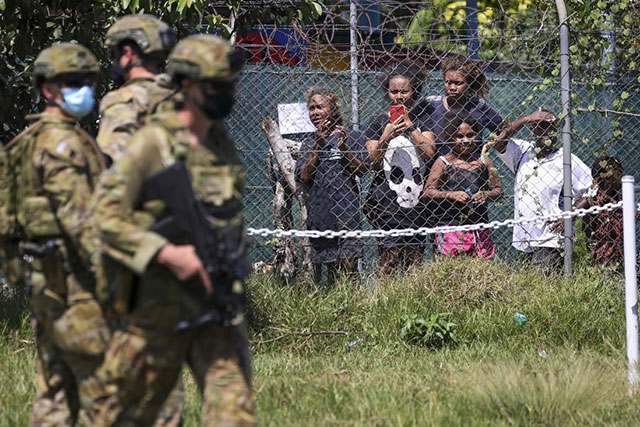
Australian “peacekeeping” troops patrol streets in Honiara, Solomon Islands in November 2021 after imperialist-provoked anti-China riots. Australian troops out of the Pacific Islands! (Photo: AP)
The western Pacific has long been the scene of “great power” rivalry. The U.S. Navy under Commodore Matthew Perry forced Japan at gunpoint in the 1850s to trade with the West. Already in the 1600s, the Dutch East India Company had begun colonising what would later become Indonesia, formalising control in 1796. The Spanish controlled the Philippines from the 1500s until the U.S. took over in the Spanish-American War of 1898. Britain colonised Australia and New Zealand and established the British Western Pacific Territories to include those island groups that protected the southwest approaches to the main archipelagos of the Philippines and Indonesia to the north. In what became Papua New Guinea and in the Pacific islands, the indigenous peoples were treated like virtual slaves on the large plantations of the European colonisers. Tens of thousands of labourers were kidnapped from the islands to work on land in Australia beginning in the 1840s, a practice infamously known as “blackbirding”.
During the inter-imperialist Second World War, the U.S. and Australia needed to enlist Pacific Islanders in the anti-Japanese war effort. The Japanese military never intended to invade the Australian mainland, regarding it as too difficult and not worth the effort. But they were interested in blocking the U.S. supply routes to Australia, which involved control of the southwestern Pacific islands. Bitter battles took place throughout these islands; thousands of islanders were killed. And in the conflict between Japanese and American imperialism, over 3 million Japanese died and Japan became the only nation ever to be attacked with nuclear weapons, by “democratic” U.S. imperialism. After the war, the U.S. largely withdrew from the smaller Pacific islands, the British Empire crumbled and Australia moved in, treating the native populations little better than had the British. Most of the former British colonies achieved independence by the 1970s. An extreme level of poverty gives lie to the haughty claims by the Australian government to be “part of the [Pacific Islands] family.”
As a second-tier imperialist power, Australia has laid waste to the Pacific, subjugating its peoples and enforcing their poverty for the better part of a century. This included its colonial rule in Papua New Guinea, and more recently, military occupations in East Timor and the Solomon Islands. The Labor government and the ruling elite for which it speaks is currently bullying the various Pacific states to align with the U.S. war drive against China, while also aggressively pushing the interests of the Australian gas and oil corporations. In addition, the ALP government has recently brought in a new visa policy for farm labourers from the Pacific Islands which will be a backdoor for low-paid labour and racial abuse.
Meanwhile, the ALP upholds one of the world’s most racist immigration systems, including the policy of “turn the boats back on the high seas.” This murderously violates the right of asylum – as well as United Nations conventions that Australia has signed on to, but, like every other imperialist country, regularly violates. Any would-be migrants that get through are detained in offshore detention prisons on the islands of Nauru and Manus, Papua New Guinea for years while they are “processed.” (These hell holes are operated as profit-making enterprises; the U.S.-based operator of the Nauru facility, MTC, has been accused of fraud, profiteering and gross negligence in Texas and California courts.) And, since 2013, all asylum seekers arriving by boat are informed that they will never be allowed to settle in Australia.
The Pacific Theater and the Imperialist Drive to WWIII
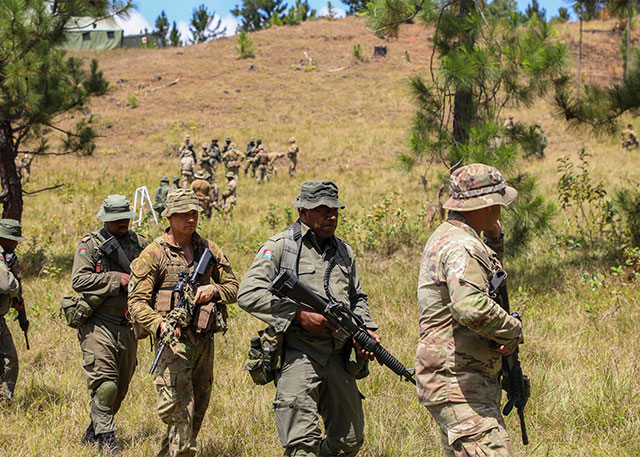
U.S., Australian, British, New Zealand and Fiji soldiers in Exercise Cartwheel maneuvers (in Fiji), September 2022, aimed at testing “expeditionary readiness and interoperability” – i.e., getting ready for a joint invasion of a Pacific island. The exercise is named after the U.S. “island-hopping” operation in World War II. (U.S. Army Pacific)
U.S. military plans for war against China focus on securing the island chains to its east in the Pacific.5 The first line – of Japan, Okinawa, Taiwan, the Philippines – is to be fortified to restrict the Chinese navy, and especially its submarines, to the relatively shallow waters from the Sea of Japan and the East China Sea down to the South China Sea. But unsure of its ability to “contain” China behind the first island chain (among other things because there is considerable support for China in Taiwan and the Philippines), imperialist war planners in the Pentagon and U.S. military think tanks are looking to direct military confrontation in the “second island chain” from the Northern Marianas and Guam to the south.6 This includes forming new units, such as littoral combat regiments whose recent war games were observed by a half dozen generals (see “With Mock Battles, Marines Prepare for a Pacific Island Fight,” New York Times, 3 March).
Around the region, Japan, after decades of pseudo-pacifism, has announced it will raise military spending by 60 percent over the next five years, which would give it the third-largest war budget in the world. India has conducted training with Japan and Vietnam, while India and Japan have signed several agreements typifying the region’s interlocking defence plans. Malaysia is buying South Korean combat aircraft. U.S. officials are trying to amass a giant weapons stockpile in Taiwan to make it a bristling “porcupine” that could head off a Chinese invasion, and the Philippines is planning for expanded runways, ports and four new bases to host the largest U.S. military presence in decades. Meanwhile, the U.S. Indo-Pacific Command doubled its spending in 2022, in part to develop a network of precision-strike missiles aimed at China. And as we have written, “the Pentagon has certainly war-gamed using its own submarine-launched W76-2 ‘low-yield’ nuclear warheads against Chinese atolls in the South China Sea.”7
But the imperialists do not have free rein. Indonesia, with the fourth largest population in the world and thousands of islands across strategic shipping and naval routes, is recently estranged from the U.S. and has growing links to China. The chief lieutenant of Indonesian president Joko Widodo said of the Chinese in a recent interview, “They never, ever dictate,” adding: “I told Washington … The way you deal with us, forget it.”8 But while China is looking to regional powers like Indonesia in its quest for a “multipolar” world order, it should be recalled that Mao Zedong courted Jakarta in the 1960s in the name of building a “nonaligned” movement, with the nationalist president Sukarno. The result was the horrific 1965 massacre of half a million to a million Communist Party members, sympathisers, trade unionists and ethnic Chinese at the hands of the Indonesian military and its death squads.
That slaughter was the price of Mao’s Stalinist policy of promoting political alliances with bourgeois forces as the counterpart to the illusion of building “socialism in one country.” Today, despite a veneer of “reformasi” (reform), military figures from the dictatorship of General Suharto who ruled Indonesia from 1965 to 1998 are still influential under the “democrat” Widodo. And while the Chinese deformed workers state is under siege from imperialist Cold War alliances from NATO to AUKUS, the nationalist bureaucracy headed by Xi Jinping adheres to the disastrous Stalinist policies of class collaboration, threatening the foundations of the Chinese Revolution. To defend them, the Chinese workers must carry out a political revolution to establish the proletarian democracy of workers councils (soviets) and the Leninist policy of revolutionary internationalism – which requires the leadership of a genuine communist (Trotskyist) party.
From Australia, New Zealand and the Pacific Islands to all of East Asia, North America and Europe, the central task facing those who seek defeat the imperialist war drive – and the threat of thermonuclear World War III that it poses – is to build the nucleus of genuinely communist, Leninist-Trotskyist workers parties on the internationalist program of world socialist revolution.
For international workers strike action against the U.S./NATO imperialist war drive against Russia and China! Defend China against imperialism and counterrevolution!
Australian unions: black ban all military shipments to NATO and Ukraine!
Down with Australia’s racist, anti-immigrant measures! Close the internment camps at Nauru and Manus – let the refugees in! Full citizenship rights for all immigrants!
Not discriminatory temporary work permits but equal rights and equal pay for all workers!
For a workers government and socialist revolution in Australia together with a voluntary socialist federation of the Pacific Islands! Independence for New Caledonia (Kanaky)!
For working-class solidarity and revolutionary internationalism – Reforge the Fourth International! ■
- 1. See “Biden Escalates Anti-China War Plans,” The Internationalist No. 64, July-September 2021.
- 2. The Australian Labor Party is a historic example of what V.I. Lenin called a “bourgeois workers party”; the ALP arose from and built its base in the union movement but with a bourgeois program, including grotesque promotion of racist and anti-immigrant “White Australia” policies.
- 3. Malaita is the Solomons’ second largest island after Guadalcanal. Following the diplomatic switch from Taiwan to China, Malaita’s premier protested, banned Chinese companies and continued to accept aid from Taiwan and the U.S. In November 2021 rioters led by “Malaita for Democracy” attempted to depose Sogavare and burnt and looted much of the Chinatown district of the Solomons’ capital Honiara.
- 4. See “U.S. Anti-China War Provocations Over Taiwan,” The Internationalist No.67-68, May-October 2022.
- 5. See U.S. Department of Defense, Indo-Pacific Strategy Report (June 2019).
- 6. See article by Rand Corporation analyst Derek Grossman, “America Is Betting Big on the Second Island Chain,” The Diplomat, 5 September 2020.
- 7. See “Defend Russia, China Against War-Crazed U.S. Rulers,” The Internationalist No.67-68.
